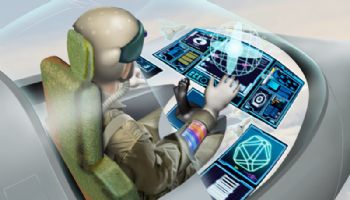
Recognising that aircraft technologies are becoming increasingly complex and that sources of data continue to multiply — making it increasingly hard for pilots to quickly access, assess and act on critical information — experts at BAE Systems (
www.baesystems.com) are developing technologies designed to enable pilots to control the fighter jet of the future with the ‘blink of an eye’.
BAE Systems’ specialist team of Human Factors engineers are collaborating with pilots to better understand and anticipate their needs in this challenging environment and enable them to control the cockpit in new ways.
Lead technologist Jean Page said: “In terms of future concepts, we are looking at what we are calling a ‘wearable cockpit’.
Here, you remove many of the physical elements of the cockpit and replace it with a virtual display, projected through the helmet.
Essentially, it is a software-only cockpit that’s upgradable, adaptable and reconfigurable.
“In such a world, we need to think about what controls are critical to the pilot and then make them easier to manage.
“Eye-tracking gives you the option of looking at something to highlight it and then making a gesture to ‘press’ a button, rather than having a series of physical buttons on the aircraft.”
Ms Page went on to say that in cockpit design terms, simply understanding where a pilot is looking during a particular phase of a mission is hugely beneficial.
“The really clever bit will be that, based on where the pilot is looking, we can infer the goal and use intelligent systems to support task performance and reduce the pilot’s workload.
"We want to do it in a way that doesn’t always ask for permission, because that would get very annoying very quickly; equally, it isessential that it is always evident to the pilot what task the intelligent system is performing.”
The BAE Systems Human Factors team demonstrated this approach in the ‘future combat aircraft’ concept model, Tempest, which was unveiled for the first time at the 2018 Farnborough International Airshow.
This concept model, developed by the UK Ministry of Defence, the RAF and industry partners (including BAE Systems), illustrates how technologies such as eye tracking will shape the types of cockpit that are expected in the combat air systems of the future.